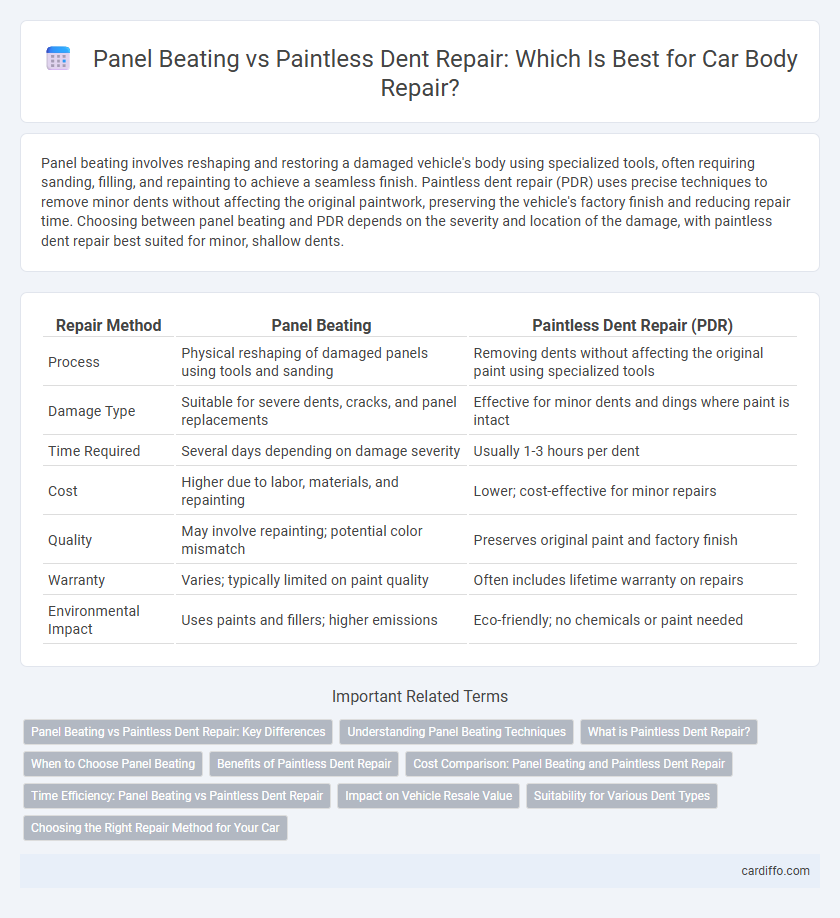Panel beating involves reshaping and restoring a damaged vehicle's body using specialized tools, often requiring sanding, filling, and repainting to achieve a seamless finish. Paintless dent repair (PDR) uses precise techniques to remove minor dents without affecting the original paintwork, preserving the vehicle's factory finish and reducing repair time. Choosing between panel beating and PDR depends on the severity and location of the damage, with paintless dent repair best suited for minor, shallow dents.
Table of Comparison
| Repair Method | Panel Beating | Paintless Dent Repair (PDR) |
|---|---|---|
| Process | Physical reshaping of damaged panels using tools and sanding | Removing dents without affecting the original paint using specialized tools |
| Damage Type | Suitable for severe dents, cracks, and panel replacements | Effective for minor dents and dings where paint is intact |
| Time Required | Several days depending on damage severity | Usually 1-3 hours per dent |
| Cost | Higher due to labor, materials, and repainting | Lower; cost-effective for minor repairs |
| Quality | May involve repainting; potential color mismatch | Preserves original paint and factory finish |
| Warranty | Varies; typically limited on paint quality | Often includes lifetime warranty on repairs |
| Environmental Impact | Uses paints and fillers; higher emissions | Eco-friendly; no chemicals or paint needed |
Panel Beating vs Paintless Dent Repair: Key Differences
Panel beating involves physically reshaping damaged metal panels using tools like hammers and dollies to restore the vehicle's original form, typically requiring repainting afterward. Paintless dent repair (PDR) uses specialized techniques to manipulate the metal from behind the dent, preserving the original paint finish and resulting in faster, more cost-effective repairs for minor dents. The key differences lie in the extent of damage each method can address, with panel beating suited for severe dents and structural damage, while PDR is ideal for shallow, smaller dents without paint damage.
Understanding Panel Beating Techniques
Panel beating techniques involve the skilled reshaping and restoring of damaged vehicle body panels using hammers, dollies, and specialized tools to correct dents and deformations. Unlike paintless dent repair, which preserves the original paint, panel beating often requires sanding, filling, and repainting to achieve a smooth, factory-like finish. This method is particularly effective for severe damage where metal needs to be realigned or replaced.
What is Paintless Dent Repair?
Paintless Dent Repair (PDR) is a specialized technique for removing minor dents and dings from a vehicle's body without affecting the original paint. This method uses specialized tools to carefully massage and reshape the metal from behind the dent, preserving the factory finish. PDR is cost-effective, faster, and maintains the car's resale value compared to traditional panel beating.
When to Choose Panel Beating
Panel beating is the preferred choice for severe dents, structural damage, or scratches that have damaged the paint surface beyond repair. It involves reshaping the metal bodywork and repainting to restore the vehicle's original appearance and integrity. When dents are deep or edges are creased, panel beating ensures a durable, factory-quality finish that paintless dent repair cannot achieve.
Benefits of Paintless Dent Repair
Paintless Dent Repair (PDR) preserves the original paint finish, maintaining the vehicle's factory appearance and resale value. This technique is faster and more cost-effective than traditional panel beating, reducing labor time and expenses. PDR is environmentally friendly by eliminating the need for repainting and harmful chemicals used in the panel beating process.
Cost Comparison: Panel Beating and Paintless Dent Repair
Panel beating typically costs between $50 and $150 per damaged panel depending on the extent of damage and vehicle type. Paintless dent repair (PDR) offers a more affordable solution, often ranging from $75 to $125, by preserving the original paint and avoiding extensive materials. For minor dents, PDR provides significant cost savings and faster turnaround compared to traditional panel beating methods.
Time Efficiency: Panel Beating vs Paintless Dent Repair
Panel beating typically requires several hours to days, involving sanding, filling, and repainting, making it less time-efficient for minor dents. Paintless dent repair (PDR) often takes less than an hour, as it manipulates the metal back into place without affecting the original paint. For small to medium dents, PDR provides a significantly faster turnaround compared to traditional panel beating.
Impact on Vehicle Resale Value
Panel beating often involves repainting and replacing parts, which can lead to visible repairs that reduce the vehicle's resale value. Paintless dent repair preserves the original paint and structural integrity, maintaining higher resale value by keeping the car closer to its factory condition. Resale value is generally more favorable with paintless dent repair due to minimal impact on the vehicle's appearance and authenticity.
Suitability for Various Dent Types
Panel beating is ideal for severe dents, creases, and areas with damaged paint, effectively restoring the car's body shape by reshaping and filling. Paintless dent repair excels on minor, shallow dents where the paint remains intact, preserving the original finish without the need for repainting. Choosing between these methods depends on dent size, location, and paint condition, with panel beating suited for extensive damage and paintless dent repair for lighter imperfections.
Choosing the Right Repair Method for Your Car
Choosing the right repair method for your car depends on the type and severity of damage. Panel beating involves reshaping and restoring damaged metal surfaces, ideal for larger dents with paint damage, while paintless dent repair (PDR) preserves the original paint and works best for minor dents without surface cracks. Evaluating the extent of the damage and cost-effectiveness helps determine whether traditional panel beating or PDR offers the optimal solution for maintaining your vehicle's value and appearance.
Panel beating vs paintless dent repair Infographic

 cardiffo.com
cardiffo.com